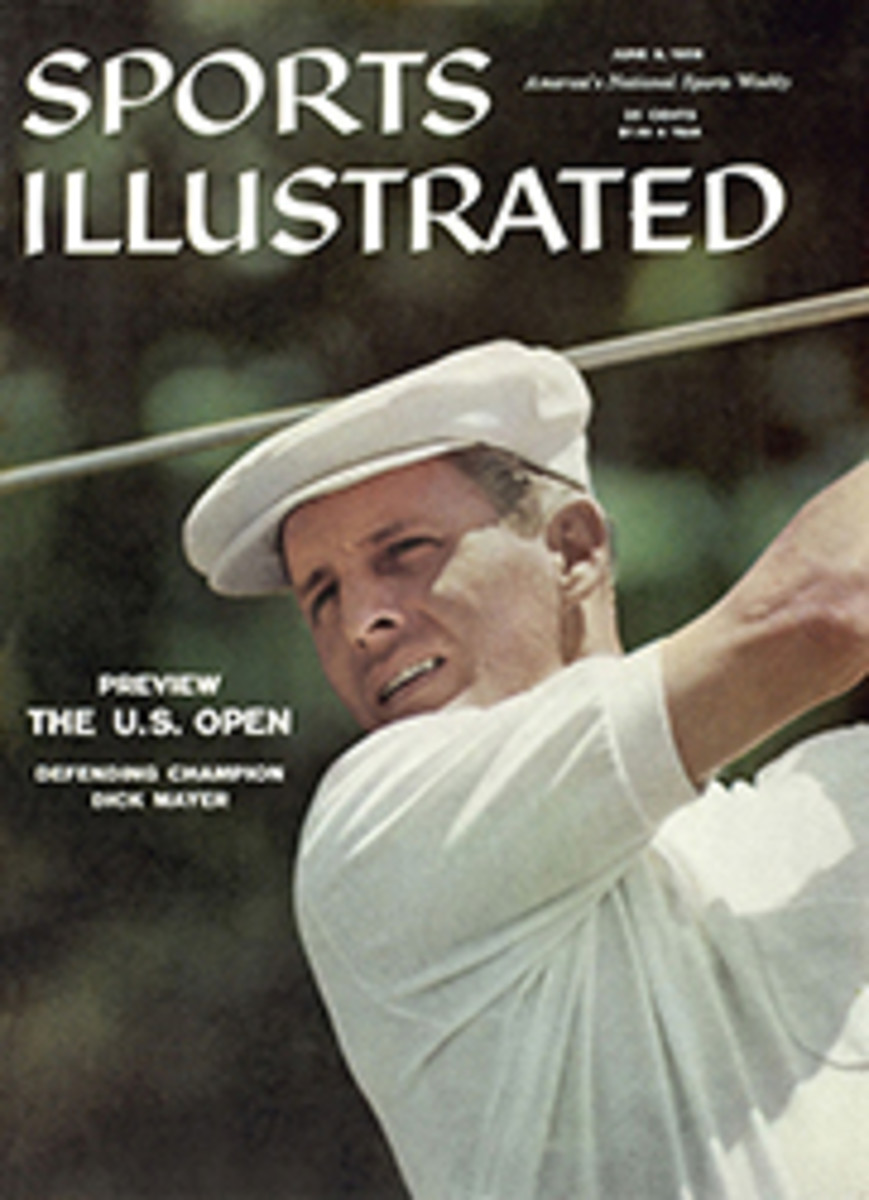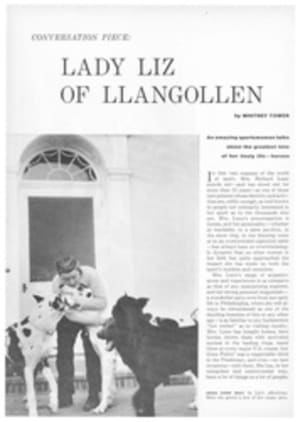
THE FATAL GAMBLE
The day arrived clear and hot, bringing a breeze from the southwest. With all due pageantry—balloons ascending, bombs bursting, a band marching—the 42nd Indianapolis 500-mile race was begun. Into the first mildly banked 90° turn went the 33 racers, the fastest field in the old Speedway's history. Then through the short straightaway at the south end of the 2½-mile track they sped, through the second turn and up the backstretch, gathering momentum.
Dick Rathmann, the fastest man in qualifying trials, a tough and determined driver who had had more lean years than fat, was first into the third turn. Traveling at more than 130 mph, he went low into the turn, at the inside, safely in the "groove." There was no safe passage abreast of him (he said later) for any other car. Nevertheless, one man attempted to find room. He drove "under" (inside of) Rathmann in the turn, and that gamble by Ed Elisian caused a chain reaction of violence which killed the personable and wonderfully gifted driver Pat O'Connor, sent Rookie Jerry Unser over the low concrete guard wall and removed 13 cars from effective competition before the race was one lap old.
Only a few thousand of the approximately 200,000 spectators saw the calamitous events at that rather remote corner of the track (which encloses a very large infield). The great throng alongside and at the end of the homestretch was profoundly shocked upon counting the missing as the survivors completed the lap.
The first of the fortunates who threaded safely through the unprecedented wreckage in the third turn was the eventual winner, Jim Bryan, who had started in the third row of the field. After him came the remaining unscathed survivors, then the few cars which managed to reach the pits, though battered.
At the outset the cars were to have formed up in 11 rows of three behind the pace car in the course of two nonracing laps after departing singly from the pits along the homestretch. This method worked poorly when first used last year (two cars were wrecked in the scramble for assigned positions), and atrociously last week. Rathmann, at the head of the line of cars in the pits, was shoved off by his mechanics after his engine was revved up. The pace car, however, was not yet in position to lead the field. Elisian and Jimmy Reece, the other front-row drivers, quickly followed Rathmann, and all three moved off ahead of the pace car, which then picked up the balance of the cars as they began to emerge.
Driven by the 1957 winner, Sam Hanks, and carrying Speedway Owner Tony Hulman, the pace car pulled into the pits again two laps later as if to acknowledge a proper start. But the front-row men were half a lap ahead. They decided not to wait, but to catch up with the remaining cars, and not the least of the day's shocks was the sight of Rathmann speeding down into the homestretch on the inside of the massed field next time around as Elisian and Reece caught up on the outside. The front-row men dashed into position at the head of the field and the race was on, finally, as they crossed the starting line in the prearranged order.
Many persons who could not see the accidents in the third turn believed the chaotic start to be directly responsible. This was not the case The field was in reasonably good order as the racing actually began, and the first two of the track's four turn; were negotiated safely. Obviously, however, the prerace laps did no' achieve their intended effect of settling down 33 highly strung driven for the dangerous business of the firs few racing laps, in which the field is bunched and the cars are difficult to manage because of heavy fuel loads Undoubtedly the front-row men were keyed up beyond the normal. Psychologically, then, the start may well have had some bearing upon the disaster.
What specifically started the chair of accidents was this: Elisian, driving the first truly competitive car he has had for a "500," wanting very badly to win if only to pay his debts ("I owe $30,000"), lost control of his car as he passed the flying Rathmann. Rathmann could not find racing room, spun and crashed into the wall at the outside of the turn. Elisian's gyrating car bumped Rathmann's into the wall again, all but severing the front of it behind the wheels. Rathmann blacked out for a few minutes; Elisian was unhurt.
Hard behind the front pair came Reece, a buoyant type with strong nerves and stomach, who had breakfasted on steak, Pepsi-Cola and hominy. He "had Elisian missed" when Bob Veith's car struck his from behind. That spun Reece's car around. In the wink of an eyelash O'Connor was fatally trapped.
O'Connor, Veith and Johnnie Parsons, the 1950 winner, had been in the second row at the start. Now O'Connor's blue No. 4 racer struck Reece's car head on and started to climb over it, ripping off the headrest and bending the roll bar behind it as Reece ducked. O'Connor's car soared, rolling sideways, then descended and crashed into the pavement upside down. He probably was killed at that moment—mercifully, because the car caught fire after bouncing upright, skidding into the wall of the short north straightaway and bouncing back into the middle of the asphalt track.
When Reece looked up again, he was pointed in the right direction ("the Lord was steering for me"), the engine was still running and he made his way to the pits. After hasty repair of damaged steering gear, he rejoined the race and in a remarkable comeback placed sixth at the end.
Behind O'Connor, as his car fiercely burned, the remaining drivers faced desperate decisions. Most of them chose, as Bryan did, to cut down through the grass inside the turn. High in the turn, however, Jerry Unser nosed under one car, then drove up over another, Rookie Paul Goldsmith's, and on, perforce, over the wall. He luckily landed in an open area and suffered only a shoulder dislocation. His car left a tire mark on Goldsmith's shoulder.
For 25 minutes the yellow caution lights of the track were on as the functioning cars toured slowly, while the turn was cleared. Finally the race began again in earnest, and with 24 cars in action, and for many laps, until the first round of pit stops, there was a struggle of exceptional intensity among Bryan, Tony Bettenhausen, George Amick and Eddie Sachs. They dramatized the central question in the initial accident—the nature of Elisian's decision to pass Rathmann.
The most difficult thing to do at Indianapolis is to pass a determined rival of approximately equal speed. You are unlikely to pass him in the straights; therefore, you must go deeper into the turn than usual before easing up on the accelerator, and you may not be able to hold the safest path through the turn. This kind of thing happened many times in the dogfight among Bryan and the others—and safely—yet it would be difficult to exaggerate the vigor and fire with which they drove.
In Elisian's case, the almost unanimous conclusion by other drivers and official observers is that he exceeded a reasonable limit of daring in a potentially very dangerous situation.
Rathmann condemned him; the veteran Paul Russo, whose Novi was damaged in the turn, condemned him; Duane Carter, director of racing for the United States Auto Club, immediately suspended his license. On January 1 Carter had suspended Elisian for a "mania for gambling" and going deeply into debt. He was reinstated later, but he is now barred specifically forbad racing judgment. "He went into the turn 50 mph over his head," said the angry Rathmann.
Elisian at first denied that, but later said, "Maybe I did haul Rathmann down into the corner too hard."
Undeniably, the 31-year-old Californian's sensationally fast driving in practice (his lap of 148.148 mph was the fastest ever recorded at Indy), together with his lead-foot reputation, caused much prerace worry.
Paul Russo told of sitting with Pat O'Connor on race morning: "We were both concerned about Elisian and the rest of the front row. Pat told me, 'The only thing I'm worried about is getting through that first lap without a spin.' "
But Patrick James O'Connor, of North Vernon, Ind., at the age of 29, a fine driver, a man who had said he would quit driving if he won, a man on the point of opening a new insurance business, a man with a lovely wife and small son, died in his fifth "500" without having tasted victory. He was the 11th driver to die in a "500," 47th on the list of total fatalities at the Brickyard.
The winner, Bryan, drove an extremely intelligent race in the car with which Sam Hanks won last year's "500," and received superb pit work (three stops took only 90 seconds). Johnny Boyd challenged strongly toward the end but an unscheduled stop to replace a worn right rear tire with only 19 laps to go let Bryan home free at an average speed of 133.791 mph, second-fastest for the "500." The first-place share of the record $305,217 purse was $105,574.
Three of the first five finishers (Bryan, Amick, Bettenhausen) had the radical horizontal engine layout which George Salih, owner of the Hanks-Bryan Car, conceived and introduced last year—high tribute to Salih's ingenuity. This system has many strong features, including good handling qualities with the car fuel-heavy.
Grave but exultant, the big, blond, cigar-smoking Bryan hoisted a glass of champagne in his festive garage.
"If it's your day," he said, "you can't do nothin' wrong."
[originallink:10483931:41730]
PHOTO
SOARING ABOVE SPINNING CAR OF JIMMY REECE, WHICH IT STRUCK, PAT O'CONNOR'S RACER (4) BEGINS TO ROLL OVER. AT LEFT ED ELISIAN'S CAR (5) CRASHES DICK RATHMANN'S INTO THE WALL. BOB VEITH'S CAR (LEFT CENTER) STARTED REECE'S SPIN
PHOTO
GAMBLER ELISIAN: "MAYBE I DID..."
PHOTO
WINNER BRYAN: "IF IT'S YOUR DAY..."

